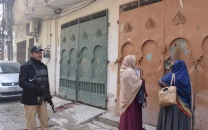Public schools: ‘Poverty factor in a lot of drop outs’
Despite govt’s efforts, enrollment has not improved, says ASER.

Despite govt’s efforts, enrollment has not improved, says ASER. PHOTO: FILE
According to the Annual Status of Education Report (ASER) 2013, to be published next week, almost 43 per cent of school drop-outs in the province were due to poverty.
For the first time, the report covering all 36 districts in the Punjab seeks to analyse the drop-out rate.
Programme Manager Safyan Jabbar said, “Efforts to increase enrollment were not translating into progress on the ground. Despite increased efforts by the government, the enrollment rate was not improving. This pointed towards the need to explore reasons behind the drop-out rate”. Jabbar said there had been no major improvements in enrollment, especially in the southern districts of the province.

Jabbar and his team studied factors like poverty, migration due to floods, the law and order situation and school mergers (last year the School Education Department had merged schools with low attendance and facilities to improve utilisation of available resources).
According to the ASER survey, the primary reason for the drop out rate was poverty. The poor law and order situation, the second most important factor, contributed 14 per cent of drop outs in the Punjab. Jabbar said “Parents were far more concerned about girls when it came to sending children to school”. He said this affected girls’ education in the long term.
Another 30 per cent of drop outs for reasons categorised as ‘other’ were individual circumstances. Jabbar said 12 per cent of the responses were placed in the category of ‘invalid’. Almost one per cent were attributed to relocation and migration due to floods. The consolidation of schools and shifting of school premises apparently did not contribute to school drop-outs.
“Unless these reasons are studied further, no amount of investment and effort can improve the situation in terms of enrollment and retention in schools”, said Jabbar.
The surveyed more than 59,000 children between the ages of three and 16 in more than 1,000 villages. The ASER provincial report on access to education and childrens’ learning levels will be released next week in Lahore.
Published in The Express Tribune, February 9th, 2014.



















COMMENTS
Comments are moderated and generally will be posted if they are on-topic and not abusive.
For more information, please see our Comments FAQ